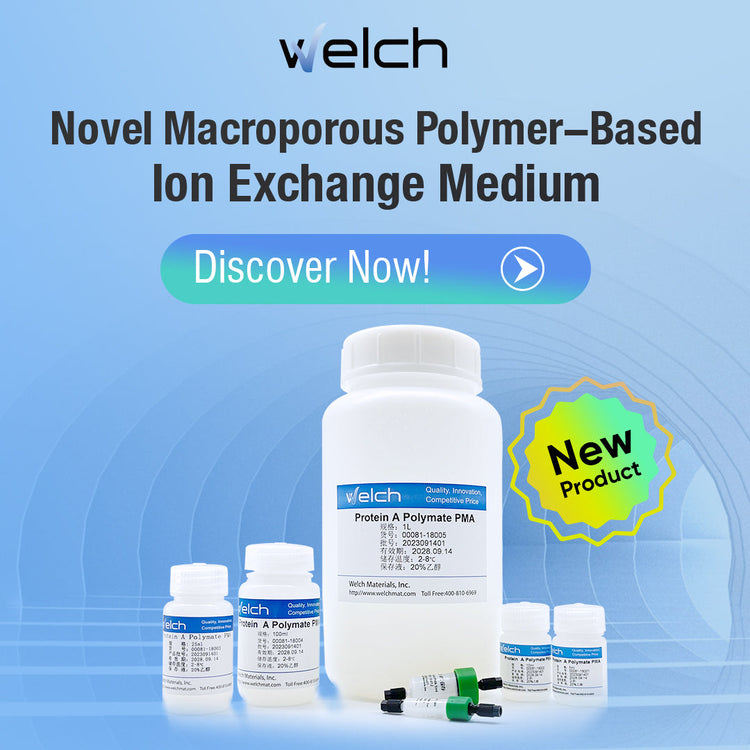Ion exchange chromatography is the most commonly used method for the separation and purification of biomacromolecules. The target protein interacts electrostatically with the ion exchange resin, and separation is achieved through the exchange of proteins with ions of the same charge on the surface of the resin. Depending on the type and strength of charges on the protein surface, cation exchange or anion exchange resins can be chosen as needed for the separation process.
Welch's Polymate IEC series ion exchange resins are based on polymers, offering excellent physical and chemical stability as well as higher mechanical strength. Through surface hydrophilic treatment, they exhibit excellent compatibility with biologically active macromolecules, allowing for the modification of different ion groups.
This series of products features large pores, high flow rates, and low back pressure, making them widely applicable for the separation and purification of antibodies, proteins, insulin, peptides, nucleic acids, antibiotics, natural products, and more. The large pore size is particularly suitable for the separation of large molecular proteins such as vaccine antigens, viruses, recombinant proteins, and antibodies.

Polymate IEC Ion Exchange Chromatography Medium
The Polymate IEC chromatography medium introduced by Welch Materials utilizes hydrophilically modified acrylic ester polymers as the backbone, with a pore size of up to 2500Å. Its pressure resistance and mass transfer properties are both outstanding.
Product Features
01Technical Specifications
| Types of Packing | SP | CM | Q | DEAE |
| Matrix | Polymethacrylate |
|||
| Activation Groups | Sulfopropyl | carboxymethyl | Quaternary Ammonium | Diethyl Aminoethyl |
| Shape | Spherical |
|||
| Average Particle Size | 60μm, distribution 48-88μm |
|||
| Pore Size | ~2500Å |
|||
| Ion Content |
0.15meq /mL |
0.4meq /mL |
0.15meq /mL |
0.15meq /mL |
| Dynamic Capacity | 25mg/mL | 35mg/mL | 25mg/mL | 20mg/mL |
| Max. Pressure | 2MPa |
|||
| Storage | 20% ethanol |
|||
02 Flow Rate-Pressure Relationship

03 Application of Packing
(1) Column Packing
- Calculate the column volume to be packed, and use 1.3 times the volume of the column for the packing material.
Prepare a suspension of the packing material with approximately 50% concentration using a 0.2M sodium chloride solution.
Pour the suspended packing material into the chromatography column and pack it using a constant pressure of 0.2 MPa.
Once the packing height stabilizes, mark the position and scale, then lower the column head to 3mm below the marked scale line. Tighten the column head seal ring to complete the column packing.
(2) Instructions for Use
The typical usage of a new chromatography column involves several steps including equilibration, sample loading, washing, elution, and regeneration.
Equilibration: Prior to use, equilibrate the newly packed chromatography column with at least 10 column volumes (CV) of equilibration buffer (e.g., 20mM or 50mM PBS or Tris HCl pH 7.2) until all baselines stabilize.
Sample Loading: Prepare the sample preferably in equilibration buffer and filter it using a 0.45μm filter membrane. Load the sample according to 80% of the dynamic capacity.
Washing: After sample loading, continue washing the column with equilibration buffer until the baselines stabilize.
Elution: Perform elution by washing the column with elution buffer (e.g., high salt buffer containing 1.5M sodium chloride) until the baselines stabilize, and collect the eluate.
Regeneration: After each chromatography run, wash the column with 1-2M NaCl solution to remove proteins strongly bound to the medium.
In-situ Cleaning: If significant decrease in medium capacity occurs, further clean the column with 5-10 column volumes of 0.1M-0.5M sodium hydroxide to remove strongly bound proteins. Then rinse the column with equilibration buffer until neutral.
Storage: After usage, flush the column with a large volume of ultrapure water to replace the buffer inside the column, followed by 20% ethanol, and seal it for storage in a refrigerator (2-5°C).
(3) Storage of Packing Material
Ion exchange chromatography packing material is initially stored in 20% ethanol upon leaving the factory and should be stored tightly sealed at 2-5°C in a refrigerator. It is recommended to replace the storage solution every two months.
Order Information (25/100/500mL,1/5L)
Pre-packed Column Order Information
(1/5 mL)
Polymate EP Polymer-based Epoxy-Activated Medium
The matrix (Polymate EP) surface contains a large number of epoxy groups, with a pore size of 2500Å. It features convenience in use, mild coupling conditions, high coupling efficiency, and a wide range of applications, making it suitable for direct coupling with various ligands.

Welch Polymate series microsphere microscopy image
Product Characteristics
01 Technical Parameters
| Parameters | Polymate EP | |
| Matrix | Acrylic Ester | |
| Ligand Bonding Method | Epoxy Bonding | |
| Particle Size | Epoxy Bonding | |
| Pore Size | 2500Å | |
| Activation Group Density | >40μmol/mL wet gel | |
| Maximum Pressure Resistance | 2MPa | |
| pH Stability | 2-13 | |
| Storage Conditions | 2~8℃, 20% ethanol |
02 Flow Rate-Pressure Relationship

Flow rate-pressure relationship graph for Polymate EP chromatography medium.
Note: All products listed in the order form are available for sample trials and can also be customized to other specifications according to customer requirements.

